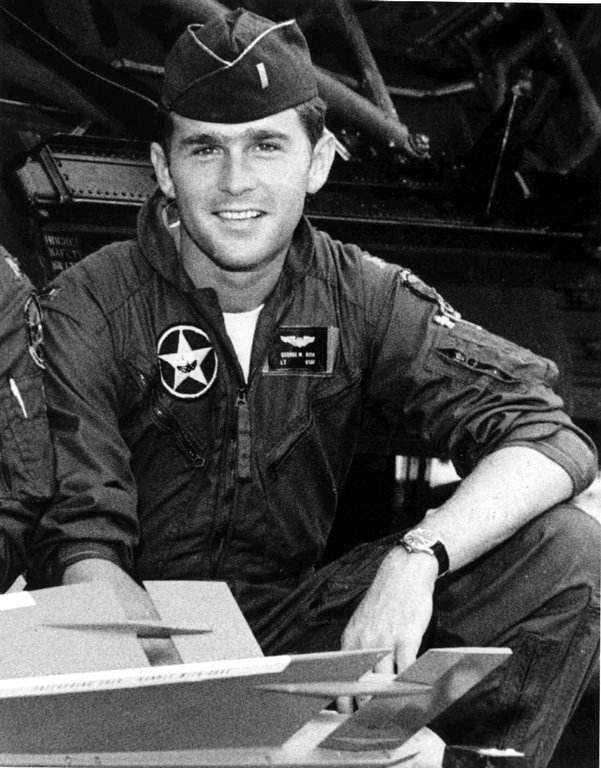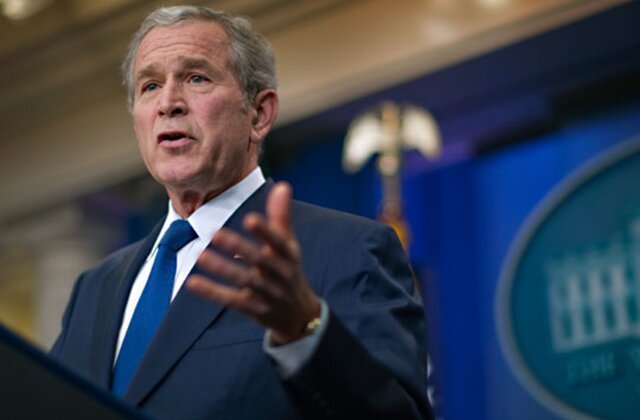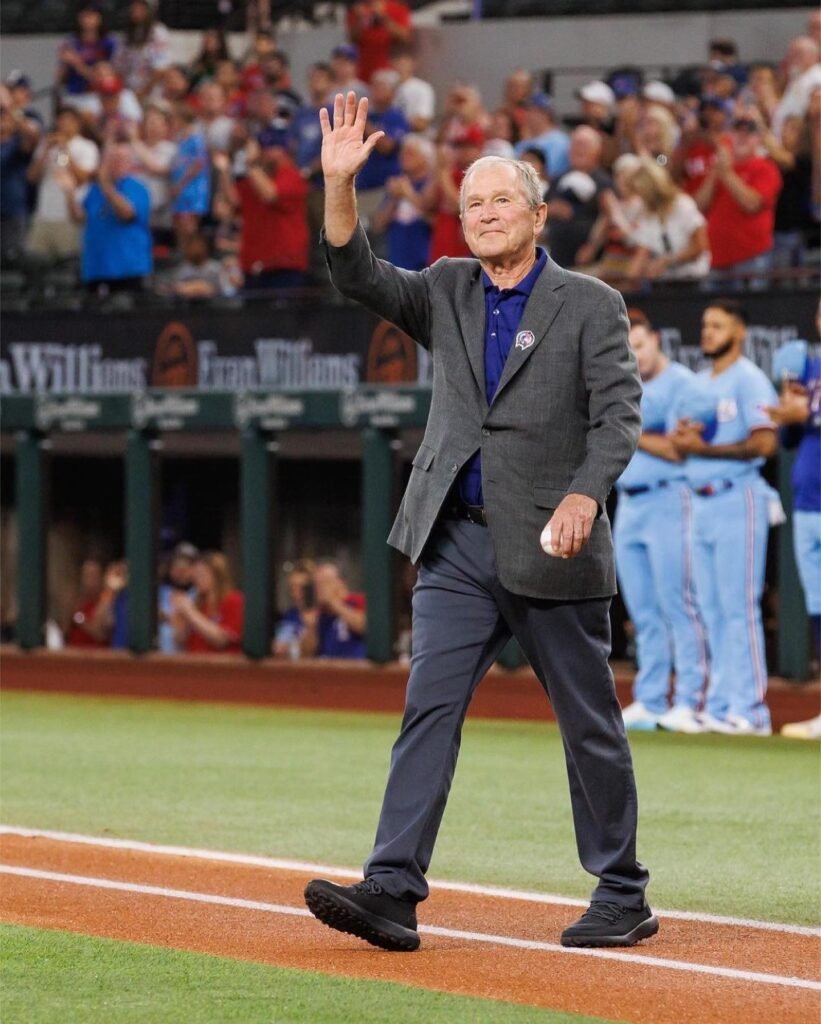George W. Bush Then and Now
George W. Bush Then
George W. Bush, born on July 6, 1946, in Connecticut, was the son of George H.W. Bush and Barbara Bush.
His early life was marked by a family deeply entrenched in political pursuits, with his grandfather, Prescott Bush, having served as a U.S. Senator from Connecticut.
Growing up in a household with four siblings, including his notable brother Jeb, George W. faced the challenges of family dynamics when tragedy struck early on with the loss of a younger sibling to leukemia at the age of three.
This familial backdrop fostered a strong sense of duty and public service that would shape his later political career.
Bush’s educational journey began with his enrollment in several prep schools before he attended a boarding school in Massachusetts.
Despite a lackluster academic record, he found his niche in extracurricular activities, notably serving as head cheerleader.
This role, while seemingly superficial, illustrated his early ability to engage and lead his peers.
He then transitioned to Yale University, where he continued to cheerleading while pursuing a degree in history.

His time at Yale was notable not only for his studies but also for his involvement in athletics, as he made the starting squad for the rugby team.
Additionally, he was initiated into the prestigious Skull and Bones Society during his final year, a hallmark of elite connections at the university.
However, his academic performance at Yale was average, which contributed to his rejection from the University of Texas Law School, a setback that would lead him to Harvard Business School.
Bush’s time at Harvard marked a significant turning point in his life. He successfully earned an MBA, making him the first U.S. president to hold this degree.
This achievement set him apart from his predecessors and provided him with a solid foundation in business, which he later applied to his political career.
Related Article: Bill Clinton Then and Now
Before venturing into politics, Bush joined the Texas Air National Guard during the Vietnam War era.
Although he did not see combat, his service included logging flight hours and participating in drills.
However, his commitment to the Guard became questionable when he missed scheduled drills and physical exams, leading to an honorable discharge.
This aspect of his service has been scrutinized, particularly in the context of the Vietnam War and the responsibilities expected of military personnel during that tumultuous period.
Ultimately, these experiences—his upbringing, education, and military service—played crucial roles in shaping George W. Bush’s trajectory toward becoming the 43rd President of the United States.
Related Article: Michelle Obama Then and Now
George W. Bush’s Political Career
George W. Bush’s political career began in earnest in 1978 when he made his first attempt to enter public office by running for the House of Representatives in Texas.
Despite a spirited campaign, he fell short, garnering 46 percent of the vote but losing the election.
This initial foray into politics did not deter him; rather, it laid the groundwork for his future endeavors.
In the years that followed, Bush took an active role in his father’s political campaigns, especially during the 1988 presidential election, where he was instrumental in mobilizing support.
His efforts included extensive travel across the country to rally voters and energize the campaign, showcasing his emerging skills in political strategy and public engagement.
Related Article: Jeff Flake Then and Now
In 1991, he was appointed as a campaign advisor for his father’s re-election bid, further solidifying his position within the political landscape.
Bush’s political ambitions took a decisive turn in 1994 when he ran for governor of Texas.
This time, his efforts paid off, and he won the election in 1995 with a solid 53 percent of the vote.
His governorship was marked by several significant initiatives that shaped Texas policy, including the introduction of concealed carry permits, which enhanced individual rights regarding firearm ownership.
Related Article: John Hickenlooper Then and Now
Additionally, he championed $2 billion in tax cuts, reflecting his commitment to fiscal conservatism.
Under his leadership, Texas emerged as the nation’s largest producer of wind-generated electricity, highlighting his focus on energy policy and innovation.
These accomplishments not only bolstered his reputation in Texas but also positioned him as a viable candidate for national office.
By 2000, as Bush completed his tenure as governor, media speculation about his potential presidential aspirations began to mount.
Related Article: Larry Hogan Then and Now

After securing re-election as governor, he announced his candidacy for the Republican presidential nomination.
During his campaign, Bush framed himself as a centrist, which differentiated him from more conservative contenders.
He promised to expand the military and cut taxes, resonating with a broad spectrum of voters.
His selection of Dick Cheney as a running mate further consolidated his ticket, and by winning the Republican nomination, he set the stage for a contentious election against Democratic candidate Al Gore.
Related Article: Tom Wolf Then and Now
The 2000 election proved to be one of the closest in American history, culminating in a Supreme Court decision that effectively awarded Bush the presidency.
Once in office, Bush initially pursued an ambitious domestic policy agenda, but the September 11 attacks dramatically reshaped his presidency.
In the aftermath of the attacks, national security became the administration’s primary focus, leading to military interventions in Afghanistan and Iraq.
These conflicts, justified under the umbrella of the War on Terror, dominated public discourse and significantly influenced Bush’s presidency.
Related Article: Sheldon Whitehouse Then and Now
The wars were central to his re-election campaign in 2004, as he portrayed himself as a resolute leader in the face of global threats.
However, despite early support from the American public, his approval ratings began to decline over time, especially as the conflicts became protracted and contentious.
The 2008 financial crisis further exacerbated the situation, contributing to his historically low approval ratings and leaving a complex legacy that continues to be analyzed and debated in American political discourse.
Related Article: Ron Wyden Then and Now
George W. Bush’s Wife and Children
In 1977, George W. Bush’s personal life took a significant turn when he met Laura Welch at a backyard barbecue in Texas.
The couple quickly developed a close bond, and by the end of the year, they were married, marking the beginning of a partnership that would endure through the challenges of public life.
Laura, who was a school teacher and librarian, brought a sense of stability and support to George W. as he navigated his burgeoning political aspirations.
Related Article: Henry McMaster Then and Now
Their family expanded in 1982 with the birth of twin daughters, Barbara and Jenna, further solidifying their commitment to family values.
The couple’s shared experiences and mutual support played a crucial role in shaping their lives, both personally and professionally, as they eventually entered the national spotlight during Bush’s political career.
Laura became an essential partner in his journey, known for her advocacy work and dedication to issues such as education and health care, which reflected their family’s values and priorities.
Together, they established a family-oriented public image that resonated with many Americans, contributing to George W. Bush’s appeal as a candidate and later as president.
Related Article: Janet Mills Then and Now
George W. Bush Now

George W. Bush, currently 78 years old, is an American politician and businessman renowned for his tenure as the 43rd president of the United States, a position he held from 2001 to 2009.
A member of the prominent Bush family and a staunch Republican, he also served as the 46th governor of Texas prior to his presidency.
His political career is marked by significant events and challenges, including the September 11 attacks, the wars in Afghanistan and Iraq, and domestic policy initiatives that aimed to address issues such as education reform and tax cuts.
Related Article: Liz Cheney Then and Now
Throughout his presidency, Bush experienced fluctuating approval ratings, making him one of the most polarizing figures in modern American political history.
After completing his second term, Bush returned to his home state of Texas, where he largely withdrew from the public eye, opting for a more private life compared to the intense scrutiny he faced while in office.
Related Article: Mike Lee Then and Now
He has since engaged in various philanthropic endeavors and has focused on his work with the George W. Bush Presidential Center, which promotes education and global health initiatives.
While he maintains a low profile, Bush occasionally weighs in on national issues and participates in charitable activities, reflecting his commitment to public service and his ongoing interest in the welfare of the country.
His legacy, shaped by both his successes and controversies, continues to be a topic of discussion and analysis as historians and the public reflect on his impact on the nation.
Related Article: Michelle Lujan Grisham Then and Now
George W. Bush’s Net Worth
George W. Bush is an American politician, businessman, and author with a net worth estimated at $50 million, reflecting his successful career in public service, significant investments in the private sector, and his post-presidential endeavors, including book deals and speaking engagements.
Related Article: Bill Lee Then and Now
FAQs
George W. Bush’s presidency was marked by significant events, including the September 11 attacks and subsequent wars in Afghanistan and Iraq, which shaped his legacy.
He faced criticism for his handling of these conflicts, as well as for domestic issues like Hurricane Katrina and the financial crisis in 2008.
His approval ratings fluctuated greatly, making him one of the more polarizing presidents in U.S. history.
George W. Bush was not defeated in an election; he served two terms from 2001 to 2009. However, he was succeeded by Barack Obama, who won the 2008 presidential election.
George W. Bush is a Christian, specifically a member of the United Methodist Church. He has often spoken about his faith and its influence on his life and presidency.
No, George W. Bush was not in World War II. He was born in 1946, after the war ended. However, his father, George H. W. Bush, served as a naval pilot during the conflict.
After leaving office in 2009, George W. Bush has remained active in public life through philanthropy, the George W. Bush Presidential Center, and various speaking engagements.
He has largely maintained a low profile but occasionally comments on political issues.
George W. Bush currently resides in Dallas, Texas, where he lives in a home he purchased after his presidency.
After his presidency, George W. Bush focused on writing books, engaging in charitable work through the George W. Bush Presidential Center, and promoting initiatives related to education, global health, and military veterans.
George H. W. Bush lost the 1992 presidential election to Bill Clinton primarily due to economic concerns, including a recession and rising unemployment, which diminished his popularity despite his previous successes in foreign policy.
Clinton’s effective campaign focused on the economy, contributing to Bush’s defeat.






























